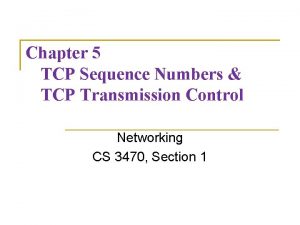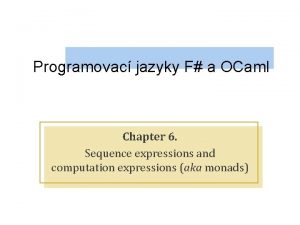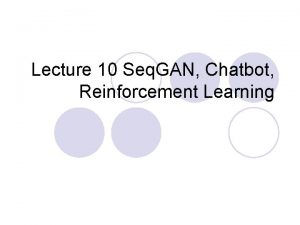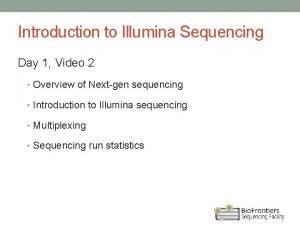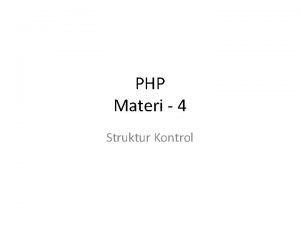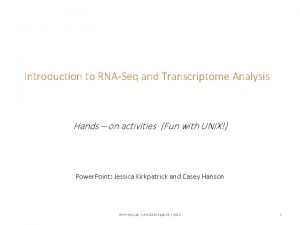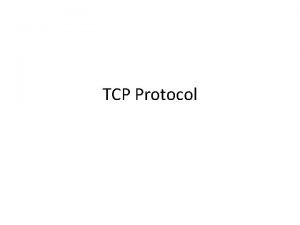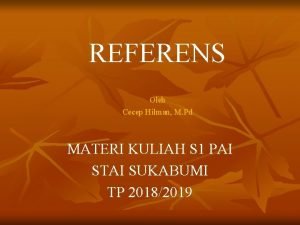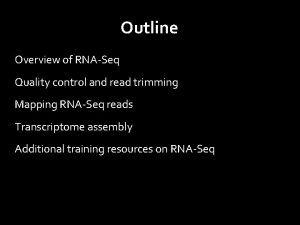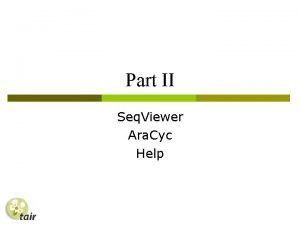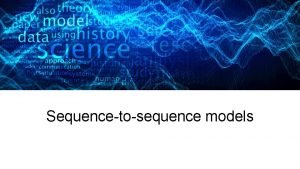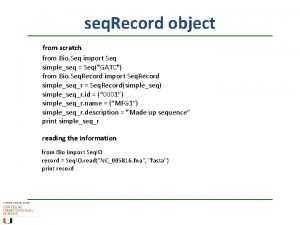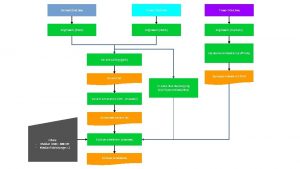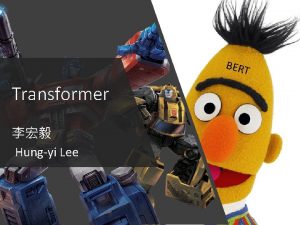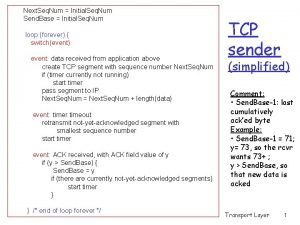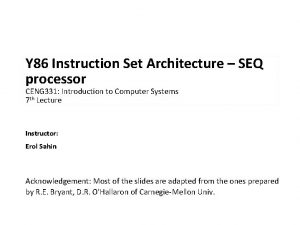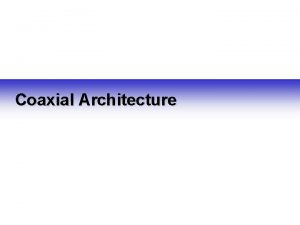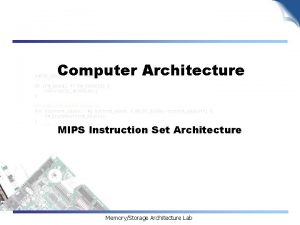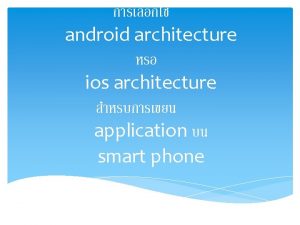The architecture of Seq 2 Seq Learning v




















































- Slides: 52



The architecture of Seq 2 Seq Learning v 1 v 3 v 2 v 4 Decoder Encoder w 1 w 2 w 3 w 4 w 5

seq 2 seq learning: Machine Translation Jordan likes playing basketball Part of Speech Jordan/NNP likes/VBZ playing/VBG basketball/NN NP Parsing S VP Jordan/NNP likes/VBZ S VP playing/VBG NP Semantic Analysis basketball/NN Jordan likes playing basketball AD V A 1 AD 乔丹 V 喜欢 A 1 打篮球

seq 2 seq learning: Machine Translation 乔丹 喜欢 Decoder Encoder 打篮球 Decoder Encoder Jordan likes playing basketball Data-driven learning via amounts of bilingual corpus (the aligned source-target sentences )

seq 2 seq learning: visual Q-A Convolutional Neural Network what is the man doing ? Encoder Decoder Riding a bike

seq 2 seq learning: Image-captioning <start> A man in a white helmet is riding a bike Decoder Encoder <start> A man in a white helmet is riding a bike

seq 2 seq learning: video action classification NO ACTION pitching Decoder Encoder pitching NO ACTION

Seq 2 seq learning: put it together Many One Output One Input Image Classification One Output Many Input One Input Image Captioning Sentiment Analysis

Seq 2 seq learning: put it together Many Output Many Input Machine Translation Video Storyline


Basic models From multilayer perceptron (MLP) to Recurrent Neural Network to LSTM/GRU l Multi-Layer Perceptron(MLP) is by nature a feedforward directed acyclic network . l An MLP consists of multiple layers and can map input data to output data via a set of nonlinear activation functions. MLP utilizes a supervised learning technique called backpropagation for training the network. l l Input Mapping Output non-linear end-to-end differentiable sequential

Basic models 前向神经网络在刻画数据分布方面的作用: universal approximation theorem A feed-forward network with a single hidden layer containing a finite number of neurons (i. e. , a multilayer perceptron), can approximate continuous functions on compact subsets of Rn, under mild assumptions on the activation function. The theorem thus states that simple neural networks can represent a wide variety of interesting functions when given appropriate parameters; however, it does not touch upon the algorithmic learnability of those parameters. One of the first versions of theorem was proved by George Cybenko in 1989 for sigmoid activation functions. l Balázs Csanád Csáji, Approximation with Artificial Neural Networks, Faculty of Sciences; Eötvös Loránd University, Hungary l Cybenko. , G. , Approximations by superpositions of sigmoidal functions, Mathematics of Control, Signals, and Systems, 2 (4), 303 -31, 1989 l Kurt Hornik, Approximation Capabilities of Multilayer Feedforward Networks, Neural Networks, 4(2), 251– 257, 1991

Basic models Backpropagate errors (误差后向传播) Paul J. Werbos (born 1947) is a scientist best known for his 1974 Harvard University Ph. D. thesis, which first described the process of training artificial neural networks through backpropagation of errors. The thesis, and some supplementary information, can be found in his book, The Roots of Backpropagation (ISBN 0471 -59897 -6). He also was a pioneer of recurrent neural networks. Werbos was one of the original three two-year Presidents of the International Neural Network Society (INNS). He was awarded the IEEE Neural Network Pioneer Award for the discovery of backpropagation and other basic neural network learning frameworks such as Adaptive Dynamic Programming. Paul J. Werbos, Backpropagation Through Time: What It Does and How to Do It, Proceedings of the IEEE, 78(10): 1550 -1560, 1990

Basic models Backpropagate errors (误差后向传播) Repeatedly adjusts the weights of the connections in the network so as to minimize the measure of the difference between the actual output vector of the net and the desired output vector. As a result of the weight adjustments, internal "hidden" units which are not part of the input or output come to represent important features of the task domain, and the regularities in the task are captured by the interactions of these units. Rumelhart, David E. ; Hinton, Geoffrey E. ; Williams, Ronald J. , Learning representations by back-propagating errors, Nature, 323 (6088): 533– 536, 1986

Basic models From multilayer perceptron (MLP) to Recurrent Neural Network to LSTM/GRU Recurrent Neural Network: An RNN has recurrent connections (connections to previous time steps of the same layer). l RNN are powerful but can get extremely complicated. Computations derived from earlier input are fed back into the network, which gives RNN a kind of memory. l Standard RNNs suffer from both exploding and vanishing gradients due to their iterative nature. sequence input (x 0…xt) Mapping Embedding vector (ht)

Basic models l Long Short-Term Memory (LSTM) Model: l LSTM is an RNN devised to deal with exploding and vanishing gradient problems in RNN. l An LSTM hidden layer consists of a set of recurrently connected blocks, known as memory cells. l Each of memory cells is connected by three multiplicative units - the input, output and forget gates. l The input to the cells is multiplied by the activation of the input gate, the output to the net is multiplied by the output gate, and the previous cell values are multiplied by the forget gate. Sepp Hochreiter &Jűrgen Schmidhuber, Long short-term memory, Neural computation, Vol. 9(8), pp. 1735 --1780, MIT Press, 1997

Basic models Gated Recurrent Unit (GRU) Gated recurrent units are a gating mechanism in recurrent neural networks, GRU has fewer parameters than LSTM, as they lack an output gate. Chung, Junyoung; Gulcehre, Caglar; Cho, Kyung. Hyun; Bengio, Yoshua (2014), Empirical Evaluation of Gated Recurrent Neural Networks on Sequence Modeling. ar. Xiv: 1412. 355

Learning with attention/ internal memory “The behavior of the computer at any moment is determined by the symbols which he is observing and his 'state of mind' at that moment. ” – Alan Turing 输出序列 在输出序列中,每一时刻的 输出依赖于所有输入数据当 时时刻的编码 输入序列

Learning with attention/ internal memory Neural Machine Translation by Jointly Learning to Align and Translate, ICLR 2015

Learning with attention/ internal memory l Google's Neural Machine Translation System: Bridging the Gap between Human and Machine Translation l Google’s Multilingual Neural Machine Translation System Enabling zero-shot translation

Learning with attention/ internal memory context vector Zt Deterministic “Soft” Attention via end-to-end learning Kelvin Xu, Jimmy Ba, Ryan Kiros, Kyunghyun Cho, Aaron Courville, Ruslan Salakhudinov, Rich Zemel and Yoshua Bengio, Show, Attend and Tell: Neural Image Caption Generation with Visual Attention, ICML 2015

Learning with attention/ internal memory Kelvin Xu, Jimmy Ba, Ryan Kiros, Kyunghyun Cho, Aaron Courville, Ruslan Salakhudinov, Rich Zemel and Yoshua Bengio, Show, Attend and Tell: Neural Image Caption Generation with Visual Attention, ICML 2015


Learning with external memory l Neural Turing Machines u Reading u Writing Graves A, Wayne G, Danihelka I. Neural Turing Machines, ar. Xiv preprint ar. Xiv: 1410. 5401, 2014, Deep. Mind J. Weston, S. Chopra, A. Bordes. Memory Networks. ICLR 2015 (and ar. Xiv: 1410. 3916, Facebook AI)

Learning with external memory l Neural Turing Machines

Learning with external memory o 可微分神经计算机(differentiable neural computer,DNC): o An achievement that has potential implications for the neural–symbolic integration problem(神经网络-符号计算的统一) o Deep neural reasoning and one-shot learning Graves, Alex, et al. "Hybrid computing using a neural network with dynamic external memory. " Nature 538. 7626 (2016): 471 -476.

Learning with external memory Deep neural reasoning (连续空间模型与离散空间模型相互协调的搜索与决策)

Learning with external memory Learning of Basic Algorithms using Reasoning, Attention, Memory (RAM) Methods include adding stacks and addressable memory to RNNs: l l l l “Neural Net Architectures for Temporal Sequence Processing. ” M. Mozer. “Neural Turing Machines” A. Graves, G. Wayne, I. Danihelka. “Inferring Algorithmic Patterns with Stack Augmented Recurrent Nets. ” A. Joulin, T. Mikolov. “Learning to Transduce with Unbounded Memory” E. Grefenstette et al. “Neural Programmer-Interpreters” S. Reed, N. de Freitas. “Reinforcement Learning Turing Machine. ” W. Zaremba and I. Sutskever. “Learning Simple Algorithms from Examples” W. Zaremba, T. Mikolov, A. Joulin, R. Fergus. “The Neural GPU and the Neural RAM machine” I. Sutskever.

Gives memory to AI Deep. Mind crafted an algorithm that lets a neural network 'remember' past knowledge and learn more effectively. The approach is similar to how your own mind works, and might even provide insights into the functioning of human minds. Much like real synapses, which tend to preserve connections between neurons when they've been useful in the past, the algorithm (known as Elastic Weight Consideration) decides how important a given connection is to its associated task James Kirkpatrick, Razvan Pascanu, et al. , Overcoming catastrophic forgetting in neural network, PNAS, http: //www. pnas. org/cgi/doi/10. 1073/pnas. 1611835114


知识计算引擎: KS-Studio http: //www. ksstudio. org/



TAC Knowledge Base Population (KBP) 2016

TAC Knowledge Base Population (KBP) 2016 u Task 1: Cold Start KBP The Cold Start KBP track builds a knowledge base from scratch using a given document collection and a predefined schema for the entities and relations that will comprise the KB. In addition to an end-to-end KB Construction task, Cold Start KBP includes a Slot Filling (SF) task to fill in values for predefined slots (attributes) for a given entity. Person and Organization)

TAC Knowledge Base Population (KBP) 2016 u Task 2: Entity Discovery and Linking (EDL) The Entity Discovery and Linking (EDL) track aims to extract entity mentions from a source collection of textual documents in multiple languages (English, Chinese, and Spanish), and link them to an existing Knowledge Base (KB); an EDL system is also required to cluster mentions for those entities that don't have corresponding KB entries.

TAC Knowledge Base Population (KBP) 2016 u Task 3: Event Track The goal of the Event track is to extract information about events such that the information would be suitable as input to a knowledge base. The track includes Event Nugget (EN) tasks to detect and link events, and Event Argument (EA) tasks to extract event arguments and link arguments that belong to the same event.




KS-Studio:关系挖掘(Relation Discovery) u 正 样 本 负 样 本 u 训练:根据标注的样本,训练卷积网络和分类器 Carbonate may be a factor in the increasing incidence of heart disease. Lithium also causes cyanosis during early pregnancy Flumazenil was well tolerated, with no movement disorders reported 向量化表述 Thromboembolism is a recognized complication of heparin therapy 预测:提取句子中命名实体对,进行关系预测 A 2 -year-old child with known neurologic impairment developed a dyskinesia soon after starting phenobarbital therapy for seizures. Known causes of movement disorders were Phenobarbital and could be eliminated after evaluation. Dexmedetomidine is useful as the sole sedative for pediatric MRI. Known causes of movement disorders were Phenobarbital and could be eliminated after evaluation. Drug-induced-Disease: (Phenobarbital, movement disorders)

KS-Studio:关系挖掘(Relation Discovery) u 以Drug-induced-Disease关系提取为例 (Phenobarbital, dyskinesia) 苯巴比妥造成运动障碍



KS-Studio:Q-A问答 Fei Wu, Xinyu Duan, Jun Xiao, Zhou Zhao, Siliang Tang, Yin Zhang, and Yueting Zhuang, Temporal Interaction and Causation Influence in Community-based Question Answering, IEEE Transactions on Knowledge and Data Engineering (major revised)

KS-Studio:看图说话 l 对图像-句子等耦合数据生成组合语义,在层次化深度学 习框架下实现“看图说话” Yueting Zhuang, Jun Song, Fei Wu, Xi Li, Zhongfei Zhang, Rui Yong, Multi-modal Deep Embedding via Hierarchical Grounded Compositional Semantics, IEEE Transactions on Circuits and Systems for Video Technology, 10. 1109/TCSVT. 2016. 2606648

KS-Studio:运动识别 视频事件检测之一及Video-Captioning l 国际视频运动行为识别竞赛Thumos Challenge 2015第三名,Thumos包含了101 个视频运动类别 l 2016 Activity. Net视频运动行为识别竞赛第六名 Pingbo Pan, Zhongwen Xu, Yi Yang, Fei Wu, Yueting Zhuang, Hierarchical Recurrent Neural Encoder for Video Representation with Application to Captioning, CVPR 2016, 1029 -1038

KS-Studio:运动识别 Video Real-time video stream Recognition System Recognition results

总结:迈向人 智能 2. 0 Pan, Yunhe, 2016, Heading toward artificial intelligence 2. 0, Engineering, 409 -413

总结:迈向人 智能 2. 0 Yueting Zhuang, Fei Wu, Chun Chen, Yunhe Pan, Challenges and Opportunities: From Big Data to Knowledge in AI 2. 0, Frontiers of Information Technology & Electronic Engineering, 2017, 18(1): 3 -14

谢谢大家 Email: wufei@cs. zju. edu. cn
 Tcp seq ack
Tcp seq ack Ocaml seq
Ocaml seq Gan chatbot
Gan chatbot Illumina sequencing video
Illumina sequencing video Index.php?seq=
Index.php?seq= Tophat uiuc
Tophat uiuc Tcp header
Tcp header Seq monk
Seq monk Seq artinya
Seq artinya Slide-seq
Slide-seq Per base sequence quality
Per base sequence quality Cuadro comparativo e-learning y b-learning
Cuadro comparativo e-learning y b-learning Hình ảnh bộ gõ cơ thể búng tay
Hình ảnh bộ gõ cơ thể búng tay Bổ thể
Bổ thể Tỉ lệ cơ thể trẻ em
Tỉ lệ cơ thể trẻ em Voi kéo gỗ như thế nào
Voi kéo gỗ như thế nào Tư thế worm breton
Tư thế worm breton Chúa yêu trần thế
Chúa yêu trần thế Các môn thể thao bắt đầu bằng tiếng đua
Các môn thể thao bắt đầu bằng tiếng đua Thế nào là hệ số cao nhất
Thế nào là hệ số cao nhất Các châu lục và đại dương trên thế giới
Các châu lục và đại dương trên thế giới Công của trọng lực
Công của trọng lực Trời xanh đây là của chúng ta thể thơ
Trời xanh đây là của chúng ta thể thơ Mật thư anh em như thể tay chân
Mật thư anh em như thể tay chân Phép trừ bù
Phép trừ bù độ dài liên kết
độ dài liên kết Các châu lục và đại dương trên thế giới
Các châu lục và đại dương trên thế giới Thể thơ truyền thống
Thể thơ truyền thống Quá trình desamine hóa có thể tạo ra
Quá trình desamine hóa có thể tạo ra Một số thể thơ truyền thống
Một số thể thơ truyền thống Cái miệng xinh xinh thế chỉ nói điều hay thôi
Cái miệng xinh xinh thế chỉ nói điều hay thôi Vẽ hình chiếu vuông góc của vật thể sau
Vẽ hình chiếu vuông góc của vật thể sau Nguyên nhân của sự mỏi cơ sinh 8
Nguyên nhân của sự mỏi cơ sinh 8 đặc điểm cơ thể của người tối cổ
đặc điểm cơ thể của người tối cổ Thế nào là giọng cùng tên?
Thế nào là giọng cùng tên? Vẽ hình chiếu đứng bằng cạnh của vật thể
Vẽ hình chiếu đứng bằng cạnh của vật thể Vẽ hình chiếu vuông góc của vật thể sau
Vẽ hình chiếu vuông góc của vật thể sau Thẻ vin
Thẻ vin đại từ thay thế
đại từ thay thế điện thế nghỉ
điện thế nghỉ Tư thế ngồi viết
Tư thế ngồi viết Diễn thế sinh thái là
Diễn thế sinh thái là Dạng đột biến một nhiễm là
Dạng đột biến một nhiễm là Số.nguyên tố
Số.nguyên tố Tư thế ngồi viết
Tư thế ngồi viết Lời thề hippocrates
Lời thề hippocrates Thiếu nhi thế giới liên hoan
Thiếu nhi thế giới liên hoan ưu thế lai là gì
ưu thế lai là gì Sự nuôi và dạy con của hổ
Sự nuôi và dạy con của hổ Sự nuôi và dạy con của hươu
Sự nuôi và dạy con của hươu Sơ đồ cơ thể người
Sơ đồ cơ thể người Từ ngữ thể hiện lòng nhân hậu
Từ ngữ thể hiện lòng nhân hậu
